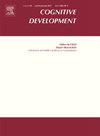Ordinal processing in children with mathematics learning disabilities
IF 1.8
3区 心理学
Q3 PSYCHOLOGY, DEVELOPMENTAL
引用次数: 0
Abstract
The present study examined whether a numerical order processing deficiency is a key factor underlying mathematics learning disabilities (MLD) in children, or whether children with MLD have a general ordinal processing deficiency. Twenty-one children with MLD were tested and compared to 32 children without MLD on three ordinal tasks (numbers, letters, lines), and two number magnitude tasks. The results demonstrate that children with MLD have a general ordinal processing deficiency as they displayed difficulties with ordered and non-ordered sequences of all three types of information. Moreover, the severity of these difficulties was equivalent for all three types of information. On the number and letter ordinal tasks they displayed reversed and standard distance effects effect akin to the controls, but larger standard distance effects on the line order task. Moreover, the children with MLD displayed difficulties with symbolic number magnitude comparison but displayed a typical standard distance effect. The combined findings of the study suggest that children with MLD have an impaired ability to access magnitude information from numerical symbols, in addition to their general ordinal processing deficiency.
Educational relevance statement
This study shows that children with mathematics learning disabilities (MLD) have severe general problems with ordinal processing (i.e., “which position or rank an item has in a set or sequence of items”), for example, judging whether three numerals are in correct order (1–2–3) or not (2–3–1). These findings suggest that screening procedures to detect children with MLD or those in risk of developing mathematical difficulties should not only include measures of number magnitude processing (i.e., “how many”), and arithmetic, but also symbolic and non-symbolic number ordinal processing as well as non-numerical ordinal processing (e.g., letters). Similarly, school support aiming at preventing mathematical difficulties in young children should target both number magnitude and number ordinal processing.
数学学习障碍儿童的序数处理
摘要本研究旨在探讨数字顺序处理缺陷是否为儿童数学学习障碍(MLD)的关键因素,或者是否有数学学习障碍的儿童有一般的顺序处理缺陷。21名患有MLD的儿童与32名没有MLD的儿童在三个顺序任务(数字、字母、线条)和两个数字大小任务上进行了测试和比较。结果表明,MLD儿童在处理三种信息的有序和非有序序列方面存在普遍的顺序处理缺陷。此外,这些困难的严重程度对所有三种资料都是相同的。在数字和字母顺序任务中,他们表现出与对照组类似的反向和标准距离效应,但在线顺序任务中,他们表现出更大的标准距离效应。此外,MLD患儿表现出符号数大小比较困难,但表现出典型的标准距离效应。该研究的综合结果表明,除了一般的顺序处理缺陷外,患有MLD的儿童从数字符号中获取大小信息的能力受损。教育相关性陈述本研究显示,有数学学习障碍(MLD)的儿童在序数处理(即“一个项目在一组或一系列项目中的位置或排名”)方面存在严重的一般性问题,例如判断三个数字的顺序是否正确(1-2-3)或不正确(2-3-1)。这些发现表明,检测MLD儿童或有发展为数学困难风险的儿童的筛查程序不仅应包括数字大小处理(即“有多少”)和算术的测量,还应包括符号和非符号数字序数处理以及非数字序数处理(如字母)。同样,旨在防止幼儿数学困难的学校支持应同时针对数字大小和数字序数处理。
本文章由计算机程序翻译,如有差异,请以英文原文为准。
求助全文
约1分钟内获得全文
求助全文
来源期刊

Cognitive Development
Multiple-
CiteScore
3.20
自引率
5.60%
发文量
114
期刊介绍:
Cognitive Development contains the very best empirical and theoretical work on the development of perception, memory, language, concepts, thinking, problem solving, metacognition, and social cognition. Criteria for acceptance of articles will be: significance of the work to issues of current interest, substance of the argument, and clarity of expression. For purposes of publication in Cognitive Development, moral and social development will be considered part of cognitive development when they are related to the development of knowledge or thought processes.
 求助内容:
求助内容: 应助结果提醒方式:
应助结果提醒方式:


